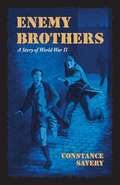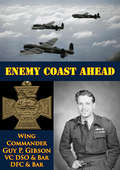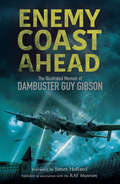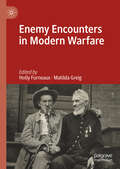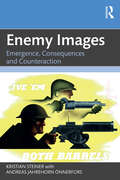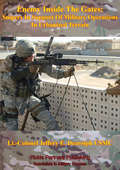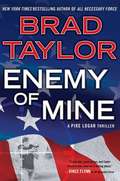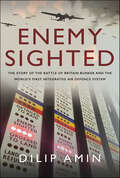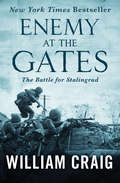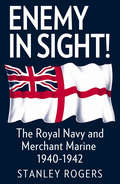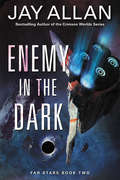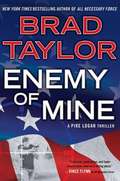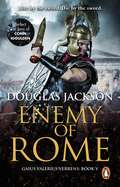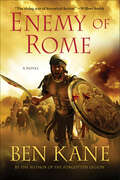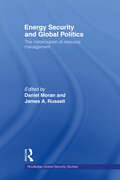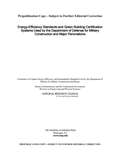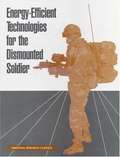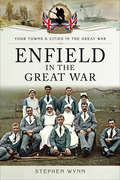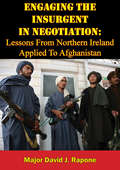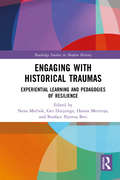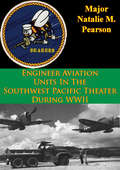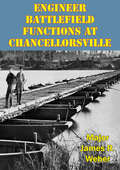- Table View
- List View
Enemy Brothers: A Story of World War II
by Constance SaveryTHEY MADE A BARGAIN... They ate their meal by the fire. A little black cat came mewing and pawing for fish. "How many lives has a cat?" Dym asked, tickling her gently under her furry chin. Tony would not answer. "Nine," said Dym. "So have you. I mean that if you run away as often as nine times you won't get into trouble when you are caught. But the tenth time you are caught running away there will be a row, a really serious row. Understand?" Tony scowled. "You've lost three of your lives already. That leaves six, doesn't it?" There were disadvantages, Tony found, in a vow of eternal silence. For example, one had no power to protest violently against such a flagrant injustice such as this. He turned his eyes glowing with indignation on Dym. "You think that's not square, eh?" But Tony was wrathfully silent. Dym's grave young face broke suddenly into a smile. Though Tony would not have owned it for the world, he liked to see his captor smile. "Not going to be tricked into speaking to me, are you, Max? I'm afraid I did it on purpose-I wanted to see whether I could make you speak. Very good, then; we'll start from tonight. You have nine lives and no more. Is that fair warning?" Tony did not answer in words. In his heart he thought it was fair enough. Thus a private war declared between Tony and the inhabitants of the White Priory. British airman Dym Ingleford is convinced that young Max Eckermann is his brother, Anthony, who was kidnapped years before. Raised in the Nazi ideology, Tony has by chance tumbled into British hands. Dym has brought him back, at least temporarily, to the family he neither remembers nor will acknowledge as his own. As Tony uses his nine attempts to escape, his stubborn anger is whittled away by the patient kindness he finds at the White Priory. Then, just as he is resigning himself to the English family, a new chance suddenly opens for him to return home-to Germany! ENEMY BROTHERS, written in the early years of World War II before the United States joined the Allied forces, is a story of faith in the face of uncertainty. As the events and relationships develop, the reader is given an inside view of the confusion war brings and the triumph of the human spirit in the midst of it. Ages 10-up
Enemy Coast Ahead [Illustrated Edition]
by Wing Commander Guy P. Gibson VC DSO Bar Dfc BarIncludes the Aerial Warfare In Europe During World War II illustrations pack with over 200 maps, plans, and photos.THE classic account of the Royal Air Force Bomber Command during World War Two.This is probably the best-known memoir by a Bomber Command Officer. The author first saw active service with 83 Squadron in 1939 flying against German naval targets. After completing 39 missions he transferred to Fighter Command where he flew as a night-fighter pilot with 29 Squadron. In 1942, he was given command of 106 Squadron. Such was his success flying Lancasters that when 617 Squadron was formed for the specific task of attacking the Ruhr valley dams, the author was given command. Awarded the VC for the famous 'Dam Busters' raid, the author was commissioned to write this book, a task which he completed shortly before his death in 1944.-Print Ed. "A remarkable piece of descriptive writing. It records the night-to-night life of a bomber pilot with modesty, humour, and a rich understanding.it is extraordinarily adult work for such a young man."..."This is a magnificent story well and simply told by as great a warrior as these islands ever bred. It is also History." Marshal of the Royal Air Force, Sir Arthur Harris
Enemy Coast Ahead: The Illustrated Memoir of Dambuster Guy Gibson (Literature And History Of Aviation Ser.)
by Guy GibsonA definitive new edition of a classic, World War II memoir, complete with more than 100 photographs, and notes from leading historians. Guy Gibson was the leader of the famous Dambusters raid, and Enemy Coast Ahead is a vivid, honest account, widely regarded as one of the best books on the Second World War. It also provides an insider&’s perspective, setting down in clear detail the challenges that the RAF faced in the war against Germany&’s Luftwaffe. Tragically, Gibson died in September 1944, when his Mosquito crashed near Steenbergen in the Netherlands. He was aged just 26. This new book has been published to mark the 75th anniversary of his death and includes an introduction by James Holland, a historian and broadcaster. It includes notes by Dr Robert Owen, the Official Historian of the No. 617 Squadron Association, and many images that have never before been published. Published in association with the RAF Museum Inspired the 1955 film The Dam Busters, starring Richard Todd and Michael Redgrave
Enemy Encounters in Modern Warfare
by Holly Furneaux Matilda GreigWhile the 1914 Christmas truces have a mythological status in British culture, intimate interactions with the enemy are, this interdisciplinary edited collection shows, a staple of modern warfare. Spanning multiple conflicts around the world, from the nineteenth century to the present Russia/Ukraine war, the chapters consider how fellow-feeling with the enemy during war has been both fueled and limited by constellations of class, gender, nationality, race, religion, sexuality, and shared experience. Scrutinizing asymmetries of power in enemy encounters, the instability of divisions between allies and enemies, and the heterogeneity of experiences within one army or side, contributors to this book confront a central question: how far is thinking of the enemy as an ‘equal’ in some way a precondition for non-violent interactions with them in war? In some cases, the ease of fraternization and reciprocity between the lines raises questions about the necessity of a clear feeling of enmity for fighting to continue, while in others, exclusionary attitudes based on racial or colonial hierarchies or the criminality of irregular warfare result in extreme violence and differential valuations of enemy lives.
Enemy Images: Emergence, Consequences and Counteraction
by Kristian Steiner Andreas ÖnnerforsThis book offers a detailed understanding of ‘enemy images’, which are used in political rhetoric to dehumanize adversaries for various purposes, such as to legitimate violent conflicts.Applying theoretical models to a strong catalogue of historical and recent examples – from blood libel narratives in medieval manuscripts, to state-sponsored children’s board games in Nazi Germany and social media posts about the wars in Gaza and Ukraine – the book identifies how ‘enemy images’ have led to the development of dominant socio-political paradigms by providing justifications for and reinforcements of violent conflicts both within and between societies. In doing so, the work offers an up-to-date, accessible and authoritative overview of how to identify, analyse, and counteract energy images – which will be key to fostering social environments of reconciliation and peacebuilding for the future.This book will be of much interest to students and scholars of peace and conflict studies, International Relations, history, political sociology, and communication studies.
Enemy Inside The Gates: Snipers In Support Of Military Operations In Urbanized Terrain
by Lt.-Colonel Jeffery E. Dearolph USMCAs the world's urban areas continue to increase in size the possibility of U. S. forces conducting military operations in urbanized terrain also increases. However, the weapon systems the U. S. procures and employs obtain maximum effectiveness in open terrain. These weapons prove less capable in urban terrain since their standoff and precision advantages suffer degradation due to buildings and the fleeting nature of enemy personnel. U. S. weaponry also causes a large amount of collateral damage that may also result in civilian casualties, which proves politically unacceptable. Potential adversaries of the U. S. realize these limitations and present a target set that proves difficult to locate and engage. The target set the enemy uses in urban terrain consists of enemy combatants mixing with non-combatants, enemy snipers, and special purpose teams...Assets the U. S. possesses that can engage elements of the enemy's urban target set include U. S. Army and Marine Corps snipers. However, a determination on whether more snipers will effectively defeat the target set requires consideration...This monograph analyzes the contemporary operating environment to articulate the enemy's urban target set. Next, a review of current U. S. Army and Marine Corps sniping doctrine, organization and training establishes the foundation for presenting the sniper's capability to defeat the urban target set. In order to provide a balanced argument, other possible solutions to engaging and defeating the target set receive consideration...Research shows that the sniper company, organized at the division level, achieves the desired effect of increasing the density of sniper teams on the urban battlefield. The costs associated with the sniper company prove acceptable, as it requires minimal expenditure concerning personnel and equipment. The division sniper company will effectively counter the enemy's urban target set without causing non-combatant casualties.
Enemy Of Mine (Pike Logan Series #3)
by Brad TaylorA tentative peace between Israel and Palestine has been brokered by the United States. But the Taskforce—a clandestine team operating outside of U.S. law to protect the country from terrorism—gets wind of an assassination attempt on the American envoy sent to solidify the treaty. The Taskforce must devote every resource to saving his life—and preventing another bloody outbreak of violence. Taskforce operator Pike Logan and his partner, Jennifer Cahill, are charged with following the assassin's flimsy trail throughout the Middle East, a trail that becomes more muddled at every turn. They must contend with terrorist organizations, independent killers, and shaky allies to uncover the biggest threat of all: an American citizen hiding a secret that may just destroy everything, including the Taskforce. Author Brad Taylor is the complete package: a writer who understands how to tell a thrilling story, who possesses the knowledge to construct an intricate and utterly believable plot—and who has more than enough on-the-ground experience to back it up. Enemy of Mine is another propulsive and compelling Pike Logan adventure that will throw readers into the middle of the action.
Enemy Sighted': The Story of the Battle of Britain Bunker and the World’s First Integrated Air Defence System
by Dilip AminEnemy Sighted is the story of the world’s first integrated air defense system and how the coalition of Hurricanes and Spitfires, Fighter Command’s Operations Rooms and Sector Stations, Radar Stations, Observer Corps posts, anti-aircraft gun and searchlight batteries, and balloon barrages, stood resolutely in the way of Operation Seelöwe, Hitler’s plan for invading Britain in the Summer of 1940. Dilip Amin provides a fascinating insight into their development and eventual operationalization. The system provided a recognized air picture, giving everyone the same information at the same time, much like computers linked through the internet do today, except, in 1939 there was no computer and there was no internet! Fundamental to its telling is the 11 Group Operations Room, today referred to as the Battle of Britain Bunker, and the people who worked there, deep below RAF Uxbridge. It was after visiting the Bunker that Churchill first uttered the immortal words, ‘Never in the field of human conflict was so much owed by so many to so few’. Hidden underground, with its large map table and squadron display boards, and balloon and weather states, it is preserved as it was on 15 September 1940, the date celebrated as Battle of Britain Day. Dilip Amin describes how the Bunker operated, transporting the reader back to the time of the Battle of France and the final evacuation from Dunkirk. He guides the reader through the Battle of Britain, examining in detail, the events of 15 September, as seen by those in the Bunker and the combat reports of those flying the Hurricanes and Spitfires on that tumultuous day. Finally, the book provides an insight into how the Bunker operated to protect Britain during the Blitz; support the exploratory raid on Dieppe; shield the troops landing in Normandy; and defend against Hitler’s V1 and V2 Vengeance Weapons. Enemy Sighted provides a compelling insight into the remarkable history of a secret Operations Room, that was pivotal within a world leading air defense system, and without which, an Allied victory in the Second World War would have been far from certain.
Enemy at the Gates: The Battle for Stalingrad
by William CraigA classic work of World War II history that brings to vivid, dramatic life 1 of the bloodiest battles ever fought--and the beginning of the end for the Third Reich On August 5, 1942, giant pillars of dust rose over the Russian steppe, marking the advance of the 6th Army, an elite German combat unit dispatched by Hitler to capture the industrial city of Stalingrad and press on to the oil fields of Azerbaijan. The Germans were supremely confident; in 3 years, they had not suffered a single defeat.The Luftwaffe had already bombed the city into ruins. German soldiers hoped to complete their mission and be home in time for Christmas. The siege of Stalingrad lasted 5 months, 1 week, and 3 days. Nearly 2 million men and women died, and the 6th Army was completely destroyed. Considered by many historians to be the turning point of World War II in Europe, the Soviet Army's victory foreshadowed Hitler's downfall and the rise of a communist superpower. Bestselling author William Craig spent 5 years researching this epic clash of military titans, traveling to 3 continents in order to review documents and interview hundreds of survivors. Enemy at the Gates is the enthralling result: the definitive account of 1 of the most important battles in world history. The book was the inspiration for the 2001 film of the same name, starring Joseph Fiennes and Jude Law.
Enemy in Sight: The Royal Navy and Merchant Marine 1940-1942
by Stanley Reginald Harry RogersEnemy in Sight, first published in 1943, is an authoritative book on the activities of the British Royal Navy and Merchant Marine in the 1940-1942 period of World War Two. Author Stanley Rogers describes all the naval battles of that time, including the sinking of the formidable German battleship Bismarck, the history of the aircraft carrier Illustrious, the capture of a German U-Boat, the Dunkirk rescue flotilla, German E-Boats, stories of survival at sea, and much more, making Enemy in Sight a valuable historical resource and essential reading on the Allied navies and their crews in the Second World War. Included are 16 pages of photographs.
Enemy in the Dark
by Jay AllanAfter successfully completing their mission to rescue Marshal Augustin Lucerne's daughter, Astra, the crew of the Wolf's Claw are enjoying some well-deserved rest--all, that is, except Blackhawk. The gun-for-hire cannot escape Lucerne's relentless pleas for help against growing imperial control in the Far Stars. While Blackhawk deeply respects his friend, he fears that the power Lucerne offers will lead him back to his old, dark ways.His resistance crumbles, however, when Lucerne presents evidence that the imperial governor has been manipulating the conflicts in the Far Stars. Convinced of the deadly danger of imperial domination, Blackhawk and his crew board the Wolf's Claw once more and set out to gather intelligence on the Empire's movements--the proof Lucerne needs to unite the fractured and feuding worlds of the Far Stars into a single power bloc capable of resisting imperial aggression. But deep in the sparsely populated territory of the Far Stars, he discovers that the imperial governor's machinations are far reaching--and threaten the independence of every world this side of the Void.A man seemingly running from himself, Blackhawk is beginning to realize he can no longer remain a prisoner of his own past while the future of the Far Stars is in jeopardy.
Enemy of Mine
by Brad TaylorRetired Delta Force officer Brad Taylor returns with the third explosive installment in the Pike Logan thrillers. In retired Delta Force officer Brad Taylor’s third Pike Logan thriller, a tentative peace between Israel and Palestine has been brokered by the United States. But the Taskforce—a clandestine team operating outside of US law to protect the country from terrorism—gets wind of an assassination attempt on the American envoy sent to solidify the treaty. The Taskforce must devote every resource to saving his life—and preventing another bloody outbreak of violence. Taskforce operator Pike Logan and his partner, Jennifer Cahill, are charged with following the assassin’s flimsy trail through the Middle East, a trail that becomes more muddled at every turn. They must contend with terrorist organizations, independent killers, and shaky allies to uncover the biggest threat of all: an American citizen hiding a secret that just may destroy everything, including the Taskforce. Brad Taylor is the complete package: a writer who understands how to tell a thrilling story, who possesses the knowledge to construct an intricate and utterly believable plot, and who has more than enough on-the-ground experience to back it up. His first two books appeared on bestseller lists nationwide, including The New York Times, Publishers Weekly, and USA Today. Propulsive and compelling, Enemy of Mine is sure to join them. .
Enemy of Mine
by Brad TaylorA tentative peace between Israel and Palestine has been brokered by the United States. But the Taskforce--a clandestine team operating outside of US law to protect the country from terrorism--hears of an assassination attempt on the American envoy sent to solidify the treaty. The Taskforce must devote every resource to saving his life--and preventing another bloody outbreak of violence.Taskforce operator Pike Logan and his partner, Jennifer Cahill, must hunt down the assassin through the Middle East, following a trail that becomes more perilous at every turn. And they must deal with terrorist organizations, independent killers, and shaky allies to uncover the biggest threat of all: an American citizen hiding a secret that just may destroy everything, including the Taskforce.
Enemy of Rome: (Gaius Valerius Verrens 5): Bravery and brutality at the heart of a Roman Empire in the throes of a bloody civil war (Gaius Valerius Verrens #5)
by Douglas JacksonA gripping, adrenalin-fuelled historical page-turner from bestselling author Douglas Jackson. Perfect for fans of Simon Scarrow and Ben Kane.Readers are loving Gaius Valerius Verrens! "Once you have started you will want to read every volume in this exciting series [set] during one of the most turbulent times in Roman history" - 5 STARS "Douglas Jackson undoubtedly holds the crown as king of his genre" - 5 STARS"It is another tough book to put down" - 5 STARS"An entertaining and compelling read that makes you feel as if you were there!" - 5 STARS*****************************************LIVE BY THE SWORD. DIE BY THE SWORD.Summer, AD 69: Rome and its empire are in turmoil. The emperor Otho is dead by his own hand and his rival, Aulus Vitellius, occupies the imperial throne. However, a new challenge has arisen in the East - the legions of Titus Flavius Vespasian have declared him their Emperor.In the dry heat of an August morning, Gaius Valerius Verrens prepares for his last day on Earth. Wrongly accused of deserting his legion on the field of Bedriacum, it seems he is destined to die a coward's death. Then the executioner's hand is stayed. Vitellius' enemies will spare his life if he pledges allegiance to Vespasian. Valerius - tired of the endless slaughter - agrees. And so he must battle his way south to Rome in order to persuade his friend Vitellius to stand down for the greater good. But this is civil war and this is Rome, and Valerius - his loyalties divided and branded an enemy of the people - is trapped in a maze of distrust, corruption, betrayal and blood-letting . . .Gaius Valerius Verrens's adventures continue in Scourge of Rome.
Enemy of Rome: A Novel (Hannibal #1)
by Ben KaneAs Rome rose to power in the 3rd century BCE there was only one real rival in the Mediterranean—Carthage. In the First Punic War, the Roman legions defeated and humiliated Carthage. Now Hannibal, a brilliant young Carthaginian general, is out for revenge. Caught up in the maelstrom are two young boys, Hanno, the son of a distinguished soldier and confidant of Hannibal, and Quintus, son of a Roman equestrian and landowner. A disastrous adventure will see Hanno sold into slavery and bought by Quintus's father. Although an unexpected friendship springs up between the two boys—and with Quintus's sister, Aurelia—the fortunes of the two warring empires will tear them apart. In Ben Ken's Hannibal: Enemy of Rome, they find themselves on opposite sides of the conflict and an alliance forged through slavery will be played out to its stunning conclusion in battle."A master of his discipline rightly hailed as one of the best historical novelists writing today." --Daily Express
Energy Reduction at U.S. Air Force Facilities Using Industrial Processes
by Rapporteur Gregory EyringThe Department of Defense (DoD) is the largest consumer of energy in the federal government. In turn, the U. S. Air Force is the largest consumer of energy in the DoD, with a total annual energy expenditure of around $10 billion. Approximately 84 percent of Air Force energy use involves liquid fuel consumed in aviation whereas approximately 12 percent is energy (primarily electricity) used in facilities on the ground. This workshop was concerned primarily with opportunities to reduce energy consumption within Air Force facilities that employ energy intensive industrial processes--for example, assembly/disassembly, painting, metal working, and operation of radar facilities--such as those that occur in the maintenance depots and testing facilities. Air Force efforts to reduce energy consumption are driven largely by external goals and mandates derived from Congressional legislation and executive orders. To date, these goals and mandates have targeted the energy used at the building or facility level rather than in specific industrial processes. In response to a request from the Deputy Assistant Secretary of the Air Force for Energy and the Deputy Assistant Secretary of the Air Force for Science, Technology, and Engineering, the National Research Council, under the auspices of the Air Force Studies Board, formed the Committee on Energy Reduction at U. S. Air Force Facilities Using Industrial Processes: A Workshop. The terms of reference called for a committee to plan and convene one 3 day public workshop to discuss: (1) what are the current industrial processes that are least efficient and most cost ineffective? (2) what are best practices in comparable facilities for comparable processes to achieve energy efficiency? (3) what are the potential applications for the best practices to be found in comparable facilities for comparable processes to achieve energy efficiency? (4) what are constraints and considerations that might limit applicability to Air Force facilities and processes over the next ten year implementation time frame? (5) what are the costs and paybacks from implementation of the best practices? (6) what will be a proposed resulting scheme of priorities for study and implementation of the identified best practices? (7) what does a holistic representation of energy and water consumption look like within operations and maintenance?
Energy Security and Global Politics: The Militarization of Resource Management (Routledge Global Security Studies)
by James A. Russell Daniel MoranThis book analyses the strategic dimensions of energy security, particularly where energy resources have become the object of military competition. The volume explores the risks that may arise from conditions of increasing economic competition and resource scarcity, and the problems that may follow if major producers or consumers of energy lose con
Energy-Efficiency Standards and Green Building Certification Systems Used by the Department of Defense for Military Construction and Major Renovations
by National Research Council Division on Engineering and Physical Sciences Board on Infrastructure and the Constructed Environment Committee to Evaluate Energy-Efficiency and Sustainability Standards Used by the Department of Defense for Military Construction and RepairCongress has an ongoing interest in ensuring that the 500,000 buildings and other structures owned and operated by the Department of Defense (DOD) are operated effectively in terms of cost and resource use. Section 2830 of the National Defense Authorization Act for fiscal year requires the Secretary of Defense to submit a report to the congressional defense committees on the energy-efficiency and sustainability standards used by DOD for military construction and major renovations of buildings. DOD's report must include a cost-benefit analysis, return on investment, and long-term payback for the building standards and green building certification systems, including: (A) American Society of Heating, Refrigerating and Air-Conditioning Engineers (ASHRAE) Standard 189.1-2011 for the Design of High-Performance, Green Buildings Except Low-Rise Residential. (B) ASHRAE Energy Standard 90.1-2010 for Buildings Except Low-Rise Residential. (C) Leadership in Energy and Environmental Design (LEED) Silver, Gold, and Platinum certification for green buildings, as well as the LEED Volume certification. (D) Other American National Standards Institute (ANSI) accredited standards. DOD's report to the congressional defense committees must also include a copy of DOD policy prescribing a comprehensive strategy for the pursuit of design and building standards across the department that include specific energy-efficiency standards and sustainable design attributes for military construction based on the cost-benefit analysis, return on investment, and demonstrated payback required for the aforementioned building standards and green building certification systems. Energy-Efficiency Standards and Green Building Certification Systems Used by the Department of Defense for Military Construction and Major Renovations summarizes the recommendations for energy efficiency.
Energy-Efficient Technologies for the Dismounted Soldier
by Committee on Electric Power for the Dismounted SoldierThis book documents electric power requirements for the dismounted soldier on future Army battlefields, describes advanced energy concepts, and provides an integrated assessment of technologies likely to affect limitations and needs in the future. It surveys technologies associated with both supply and demand, including energy sources and systems; low-power electronics and design; communications, computers, displays, and sensors; and networks, protocols, and operations. The advanced concepts discussed are predicated on continued development by the Army of soldier systems similar to the Land Warrior system on which the committee based its projections on energy use.
Enfield in the Great War (Your Towns & Cities in the Great War)
by Stephen WynnA historic profile of the London borough of Enfield during World War I and the conflict&’s effect on the region and its people. The Royal Small Arms Factory in Enfield was famous for producing the Lee Enfield .303 Rifle, the standard issued rifle provided to all infantry soldiers in the British Army during the First World War. The factory was so prestigious that King George V visited it in April, 1915. By the end of the war, its workforce of more than 9,000 had produced more than 2 million rifles. Their gun helped play a big part in winning the war. On July 7, 1917, the town was hit by a German air raid. Local anti-aircraft batteries did their best to thwart the enemy. Sadly, falling shrapnel from British anti-aircraft gunfire killed one woman, making her Enfield&’s only resident to be killed in the town throughout the course of the war. A nearby young boy was also struck by some falling shrapnel but survived. After the incident, members of the Government Workers&’ Union held a meeting to complain about the lack of a warning about the attack. Meanwhile, that month also saw a baker appear at Enfield Magistrates Court, charged under the Bread Order for selling loaves of bread that were over the permitted weight. For his heinous war time offence, he was fined the princely sum of ten shillings. Through researching local newspapers of the day, along with letters, diaries, photographs, parish magazines, trade journals, contemporary printed pamphlets, and more, author Stephen Wynn details the stories of Enfield during this dramatic era.
Enfield in the Great War (Your Towns & Cities in the Great War)
by Stephen WynnA historic profile of the London borough of Enfield during World War I and the conflict&’s effect on the region and its people. The Royal Small Arms Factory in Enfield was famous for producing the Lee Enfield .303 Rifle, the standard issued rifle provided to all infantry soldiers in the British Army during the First World War. The factory was so prestigious that King George V visited it in April, 1915. By the end of the war, its workforce of more than 9,000 had produced more than 2 million rifles. Their gun helped play a big part in winning the war. On July 7, 1917, the town was hit by a German air raid. Local anti-aircraft batteries did their best to thwart the enemy. Sadly, falling shrapnel from British anti-aircraft gunfire killed one woman, making her Enfield&’s only resident to be killed in the town throughout the course of the war. A nearby young boy was also struck by some falling shrapnel but survived. After the incident, members of the Government Workers&’ Union held a meeting to complain about the lack of a warning about the attack. Meanwhile, that month also saw a baker appear at Enfield Magistrates Court, charged under the Bread Order for selling loaves of bread that were over the permitted weight. For his heinous war time offence, he was fined the princely sum of ten shillings. Through researching local newspapers of the day, along with letters, diaries, photographs, parish magazines, trade journals, contemporary printed pamphlets, and more, author Stephen Wynn details the stories of Enfield during this dramatic era.
Engaging The Insurgent In Negotiation: Lessons From Northern Ireland Applied To Afghanistan
by Major David J. RaponeOutreach, negotiation and cooption may be a vital tool for counterinsurgencies as they transform conflict and facilitate Amnesty, Reconciliation and Reintegration (AR2) of warring elements within a war-torn society. This monograph utilizes a two-system comparison between the Taliban and the Irish Republican Army (IRA) to inquire if the Taliban are willing to participate in fruitful dialogue to initiate AR2. The suggestion for adopting a Northern Ireland approach for negotiation is compelling due to the strategic similarities the Taliban and the IRA share. The similarities, however, are the underlying reason why the Taliban will not be amenable to compromise within the short-term context compelled by the United States current strategy.What emerged is that the Taliban is reacting to changing environmental stimuli in the same manner as the PIRA. The direct consequence of this similarity is the likelihood of negotiations and outreach to take hold. The Taliban in 2010, like their IRA counterparts in 1972, believe they have a comparative advantage over their counterparts and are not willing to compromise their ideological convictions. Thus, policy makers in Washington, London, and Kabul should cool their rhetoric surrounding negotiation and dampen expectations that talks with the Taliban will yield significant results.
Engaging with Historical Traumas: Experiential Learning and Pedagogies of Resilience (Routledge Studies in Modern History)
by Nena MočnikThis book provides case-studies of how teachers and practitioners have attempted to develop more effective ‘experiential learning’ strategies in order to better equip students for their voluntary engagements in communities, working for sustainable peace and a tolerant society free of discrimination. All chapters revolve around this central theme, testing and trying various paradigms and experimenting with different practices, in a wide range of geographical and historical arenas. They demonstrate the innovative potentials of connecting know-how from different disciplines and combining experiences from various practitioners in this field of shaping historical memory, including non-formal and formal sectors of education, non-governmental workers, professionals from memorial sites and museums, local and global activists, artists, and engaged individuals. In so doing, they address the topic of collective historical traumas in ways that go beyond conventional classroom methods. Interdisciplinary in approach, the book provides a combination of theoretical reflections and concrete pedagogical suggestions that will appeal to educators working across history, sociology, political science, peace education and civil awareness education, as well as memory activists and remembrance practitioners.
Engineer Aviation Units In The Southwest Pacific Theater During WWII
by Major Natalie M. PearsonThe thesis of this research is that the U.S. Army aviation engineer units played a crucial role in the success of General Douglas MacArthur's island hopping campaign in the Southwest Pacific Theater at the tactical, operational, and strategic levels. Allied victory depended on seizing lightly defended enemy territory and neutralizing enemy strongpoints from Australia to the Philippines through the following pattern: conduct air and naval bombardment, land the assault forces, defeat any Japanese units in the area, and construct airfields and base facilities. This research demonstrates that aviation engineer units rapidly constructed these airbases and provided the necessary facilities for land-based aircraft so that carrier-based aircraft could focus on protecting the navy's fleet.
Engineer Battlefield Functions At Chancellorsville
by Major James R. WeberThis study investigates the significant effect of mobility, counter-mobility, survivability, and topographic engineering on the American Civil War Campaign of Chancellorsville. The operations occurred near Fredericksburg, Virginia, in April and May of 1863. In the battle, the Confederate Army of Northern Virginia decisively defeated the Union Army of the Potomac. Engineer-related considerations contributed immensely to the Confederate victory.Engineer battlefield functions influenced the operations of both armies. The Union Engineer Brigade constructed numerous pontoon bridges to overcome the river obstacles prior to and following the battle. This capability allowed the Union Army to initially surprise and envelop the Confederate Army. The natural obstacles of the rivers and forests and manmade obstacles of abatis hindered maneuver. Survivability was a significant factor during the fighting. At Chancellorsville, the Confederates used entrenchments for the first time in open operations. This strengthened their economy of force in front of the Union Army and gave "Stonewall" Jackson mass during his successful enveloping attack. Finally, topographic engineering was important through map production and reconnaissance by engineers.This study concludes that the Confederate Army integrated the engineer battlefield functions more effectively than the Union Army. In part, this explains the decisive Confederate victory.
